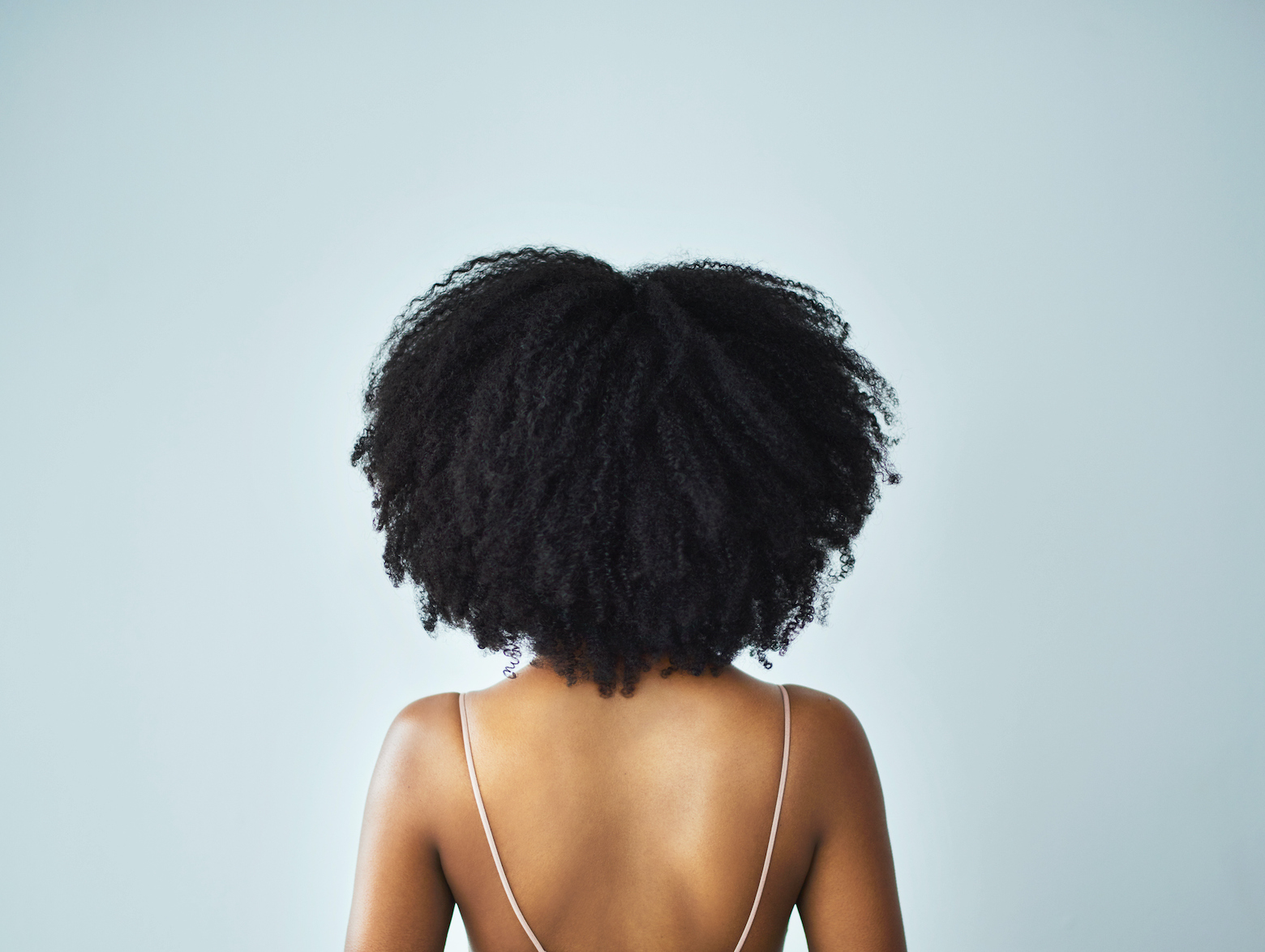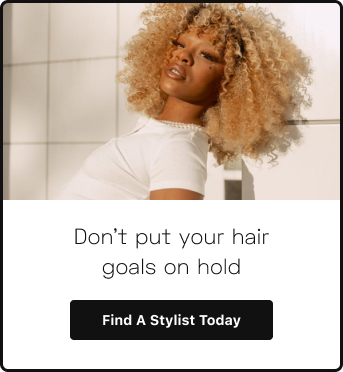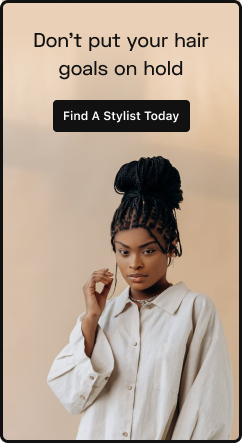According to Andre Walker’s famous hair typing system, type 4 hair is coily hair, sometimes referred to as Afro-textured or kinky. It can be soft and fine or coarse and delicate. More delicate than other types of curly hair and prone to dryness and breakage, type 4 hair is broken down into three subtypes: 4a, 4b, and 4c. The 4a hair type is closest to an S-shaped curl pattern, with lots of dense, kinky curls and volume.
Every person’s hair is different, and 4a hair can come in a wide range of hair textures and curl types. In this article, we go over the basics of the 4a hair type and give you some hair care tips for your 4a curls.
What Is 4a Hair?
4a hair, a type of coily or kinky-curly hair, is dense and thick, with curls that range in width from the size of a toothpick to a crochet needle. These tight coils make an “S” shape when elongated, making type 4a hair less prone to shrinkage than type 4b or type 4c hair when going from wet to dry.
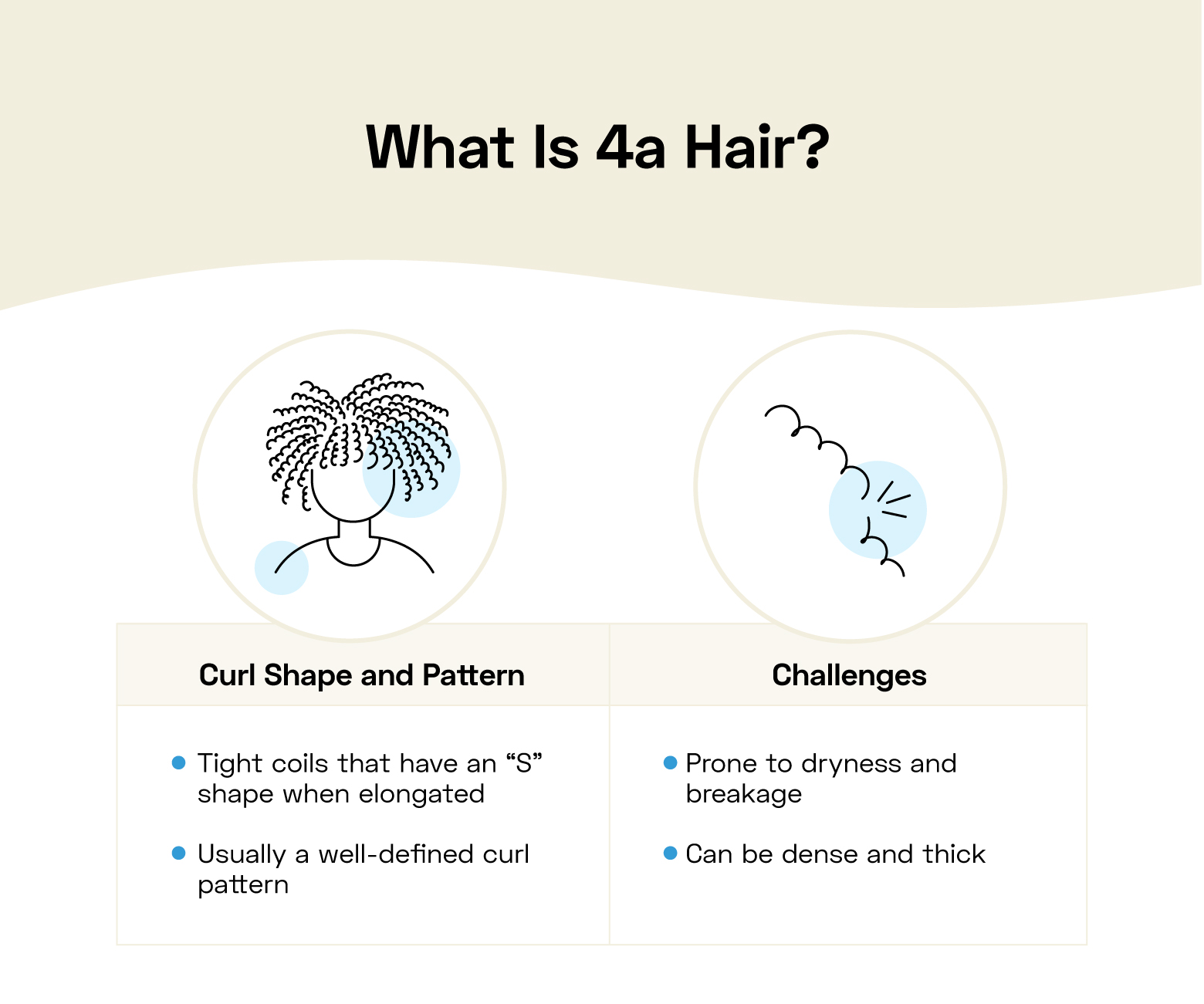
The curl pattern is usually well-defined, though hair texture and curl type can vary from person to person. Some people can even have two different curl types or a combination of textures in their natural hair.
4a Hair vs. 4b Hair
Though 4a and 4b are both kinky-curly hair types, they tend to differ in some key ways:
- Curl pattern: 4a hair has an obvious “S” curl pattern, while 4b hair tends to have “Z”-shaped curls and an overall less defined curl pattern.
- Hair texture: Type 4b hair tends to be softer, fluffier, and more delicate than 4a hair, though both can range in texture from fine to coarse.
- External factors: Though both are prone to dryness, 4b hair, being the more delicate of the two, tends to have more issues with breakage and more likely to experience shrinkage than 4a hair.
4a Hair vs. 3c Hair
4a hair is one notch above type 3c hair on the typing system, though they technically belong to different categories — type 3c is a subtype of curly hair. Here’s how they differ:
- Curl pattern: 3c hair tends to have bigger and wider curls than 4a hair, though 4a curls usually have more elasticity.
- Hair texture: Though both hair types have volume, 3c hair is denser and less coarse than 4a hair.
- External factors: Both are prone to dryness, but 4a hair dries out much more than 3c hair does, and requires more maintenance, like deep conditioning, to keep it soft and well-defined.
How to Determine Your Curl Type
You can figure out what type of hair you have by determining your curl type so you can best take care of your natural hair.
Consider these factors to figure out your curl type:
- Analyze your hair while it’s wet. If your hair is kinky-curly, it will look wavy or curly even when wet and shrink by at least 25% when it’s fully dry.
- Determine your curl family. Each subtype has its own characteristic curl: loose waves, tightly wound coils, “C”-shaped, “S”-shaped, or “Z”-shaped.
- Consider your curl shape. With type 4 hair, the tighter the curl, the higher the subtype, so type 4a is the loosest curl and type 4c is the tightest.
How to Take Care of 4a Hair
You can individualize your 4a hair care routine by following the general hair care tips in the following sections.
Wash Day Routine for 4a Hair
Because it’s so prone to dryness, breakage, and frizz, pay special attention to wash day for 4a hair.
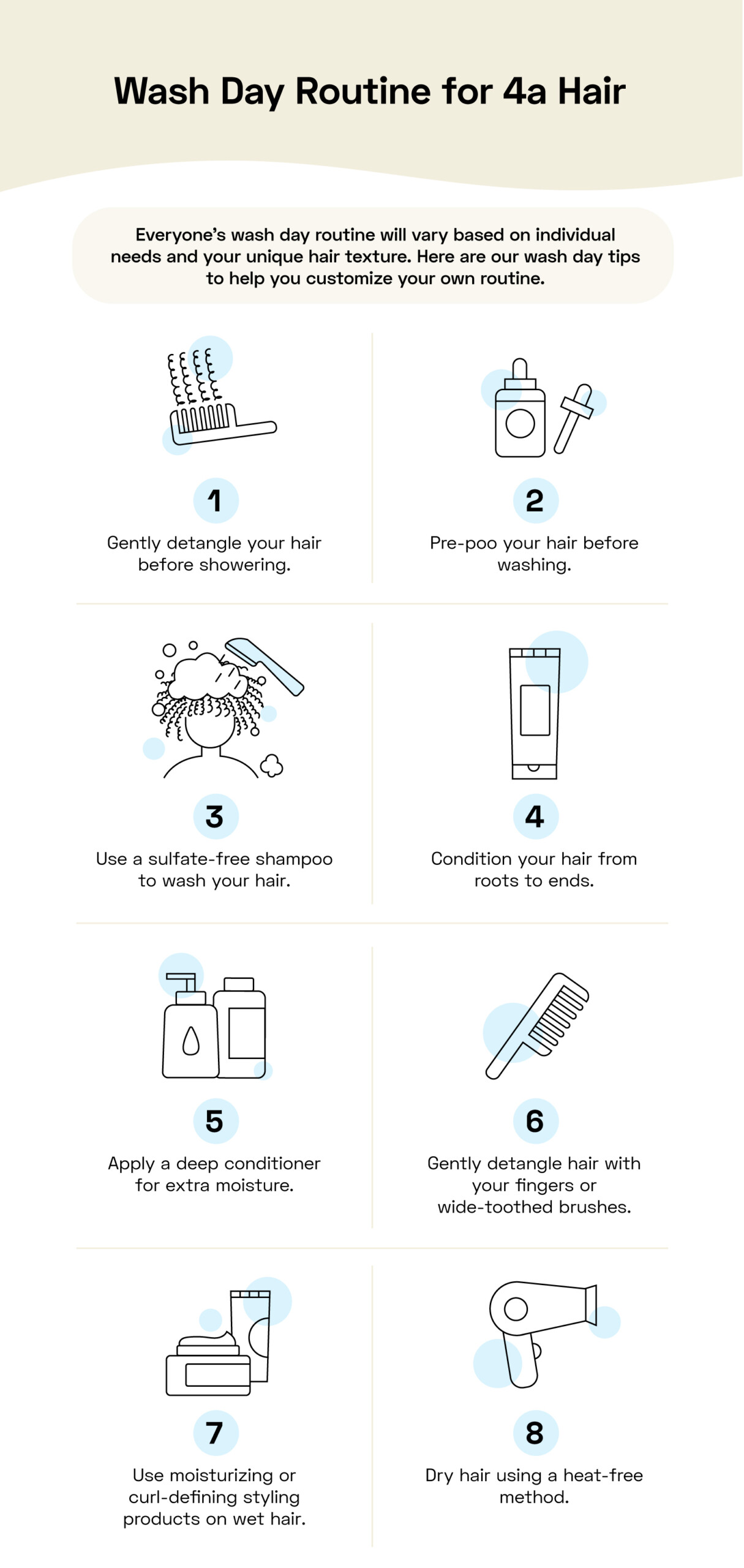
1. Gently Detangle Your Hair Before Showering
Dry detangling your hair means working out some or all of the knots or matting before you wet your hair. You can detangle with your fingers or a wide tooth comb before you step into the shower because wetness and hair products can encourage tangles or breakage.
2. Pre-poo Your Hair Before Washing
You can treat your hair with a special hair product, usually one that moisturizes or clarifies, before you shampoo. Pre-pooing your hair before you shampoo can help keep your hair protected and moisturized during your cleansing routine, so that it doesn’t dry out or get too stripped of its natural oils.
3. Use a Sulfate-Free or Clarifying Shampoo to Wash Your Hair
Use a shampoo without sulfates, the ingredients in shampoos that strip your hair of its natural oils. Sulfate-free shampoos let you cleanse without drying out your hair.
Clarifying shampoos address the other side of the problem. Leave-in conditioners help lock in hydration, but too much deep conditioning can cause oily buildup. Using clarifying shampoos once or twice a month helps balance out all the conditioning you need.
4. Condition Your Hair from Roots to Ends
Having hair that’s prone to frizz and dryness means you have to moisturize. Conditioners can help you hydrate more intensely, especially conditioning products that penetrate the hair shaft. Segment your hair into multiple sections, applying conditioner from root to tip, and leave your conditioner in for at least two to three minutes before rinsing.
5. Apply a Deep Conditioner for Extra Moisture
Deep conditioning offers your hair a little more hydration. Section your hair and apply conditioner from root to tip. Then, instead of rinsing, cover your hair with a cap or bonnet, and sit under a steamer for at least 20 minutes. If you don’t have a steamer, a warm towel around your cap can do the trick.
6. Gently Detangle Hair with Your Fingers or Wide-Toothed Brushes
Detangling after a wash is just like detangling before one — be patient and gentle with your delicate curls. Sectioning your hair might make it easier to detangle. You can either use your fingers or a tool designed for kinky hair, like a wide-toothed comb or paddle brush.
7. Use Moisturizing or Curl-Defining Styling Products on Wet Hair
Because 4a hair easily frizzes up or dries out, apply moisturizing hair products at least every other day. Moisturizing with hair oils or leave-in conditioners keeps your hair hydrated, while products like mousses can help define your coils.
8. Dry Hair Using a Heat-Free Method
Heat is damaging to all types of hair, but especially to a delicate hair type like 4a. Letting your hair air dry is the best for your hair health. You can style your curls with plopping and finger curling as it dries. If you want or need to use heat to dry your hair, you can minimize damage by applying a heat protectant first.
How Often Should You Wash Your Hair?
Typically, people with kinky-curly hair should wash once or twice a month to avoid moisture loss. However, you need to consider more than just your hair type when determining how often your hair should be washed. Consider how well it can handle a wash without getting too dry as well as how oily, sweaty, or filled with buildup it becomes.
General Care Tips for 4a Hair
You can achieve healthy hair with your own unique hair routine, and these general hair care tips can help you maintain your 4a curls between wash days.
1. Choose Products Based on Your Hair’s Unique Needs
Choose hair care products by considering three factors:
- Porosity describes your hair’s ability to absorb and retain moisture. High porosity hair is very absorbent but doesn’t retain moisture because of gaps in the hair cuticle. Low porosity hair doesn’t absorb moisture well but holds onto it once it does get through the cuticle.
- Elasticity, a sign of your hair’s strength, refers to how long a single strand of hair can stretch before it goes back to its normal appearance. If a stretched-out strand of wet hair returns to its original length when you let it go, it has high elasticity. If it breaks or doesn’t fall back into shape, it has low elasticity.
- Curl variance refers to the type or types of curls you have in your natural curl pattern. Most people have curls that fall between types or have combinations of two or more curls in their natural hair.
All of these factors determine what products will actually help your hair. For example, having low porosity hair means you’ll need more moisturizing products to lock in hydration and clarifying products to fight buildup. Depending on your hair texture, you’ll also want to choose styling products that help define and strengthen your curls rather than weigh them down.
2. Co-Wash Your Hair Between Wash Days for Extra Moisture
Skip shampoo entirely and wash your hair with only conditioner. A process called co-washing, this technique helps you add more hydration to your routine and clean your hair without stripping it. Just as shampoo rids your hair of dirt and buildup, the ingredients also tend to strip away your hair’s natural oils.
3. Refresh Your Curls with Oils and Leave-In Conditioners
If your hair needs of a refresher or an extra boost of moisture, try incorporating a leave-in conditioner, moisturizing spray, or hair oil. Natural oils like argan oil, castor oil, and coconut oil can be used for a quick refresh.
4. Don’t Skip Deep Conditioning
4a hair is very prone to dryness, so it needs all the moisture it can get. Regular deep conditioning can provide your hair with the moisture it needs and prevent it from drying out.
5. Use the Plopping Method to Dry and Style Hair in One Step
Plopping offers a heat-free drying method. Wrap your wet hair tightly in a cotton t-shirt and let it dry overnight as you sleep. Not only does it save your hair from the potential damage of a heat dry, but it also helps reduce frizz and define curls.
How to Grow 4a Hair
Delicate and prone to breakage, you may find it hard to grow 4a hair. Some of the biggest issues people with 4a hair run into are tangles and knots, scalp tension, and, at worst, hair loss. However, you can achieve the length and style you want with your 4a hair by following these tips:
- Don’t overcomb your hair or use the wrong types of combs. Combing too much, or with the wrong kind of comb, can cause breakage in your delicate strands.
- Choose a product regimen specifically for your hair. The best products for your hair health are the ones designed for your hair’s specific needs, especially when it comes to things like moisturizing and detangling.
- Remember that hair growth takes time. Don’t lose hope if it isn’t as long as you want it to be at first. Caring for your hair properly encourages growth.
- Use protective styles correctly. When done the right way, protective styles can help you avoid breakage and overdrying, make your curls more defined and your hair easier to maintain.
- Don’t overmanipulate your hair. Similar to overcombing, messing with your hair too much promotes breakage.
- Add moisture to your hair wherever you can. Keeping your hair moisturized not only prevents breakage and tangles, but also promotes your hair’s overall health and strength.
- Make sure the first ingredient of your chosen product is water. Because water moisturizes, a shampoo with water as its first ingredient is also less likely to be harsh and overdrying.
Protective Styles for 4a Hair
Protective styles are hairstyles that don’t leave your hair loose or your ends exposed. By tucking away your ends, the oldest and weakest part of your hair, your hair is less prone to breakage. Keeping your hair in a protective style also helps you maintain a hairstyle longer without the need for washing and styling.
How Long Should You Wear a Protective Style?
You can safely keep your hair in a protective style for six to eight weeks. While protective styles can be great for your hair, wearing them for too long isn’t healthy. The longer you keep your hair styled, the more buildup from natural oils you’ll have. Also, new hair growth puts pressure on your protective style, encouraging the breakage you’re trying to prevent.
Types of Protective Styles
You can choose from a variety of protective styles:
- Cornrows: Cornrows are low-maintenance, narrow braids close to the scalp.
- Bantu knots: Bantu knots are a hairstyle where the hair is parted into sections, twisted, and wrapped or stacked to form spiral knots.
- Fulani braids: Similar to cornrows, fulani braids are narrow braids, but instead of being flush against your scalp, they fall into long hair extensions.
- Twists: Twists or mini twists involves sectioning your hair, twisting the sections, letting them dry and set.
Pros and Cons of Protective Styles
Protective styles maintain hair health and look great, but you need to balance the pros and cons of wearing protective styles:
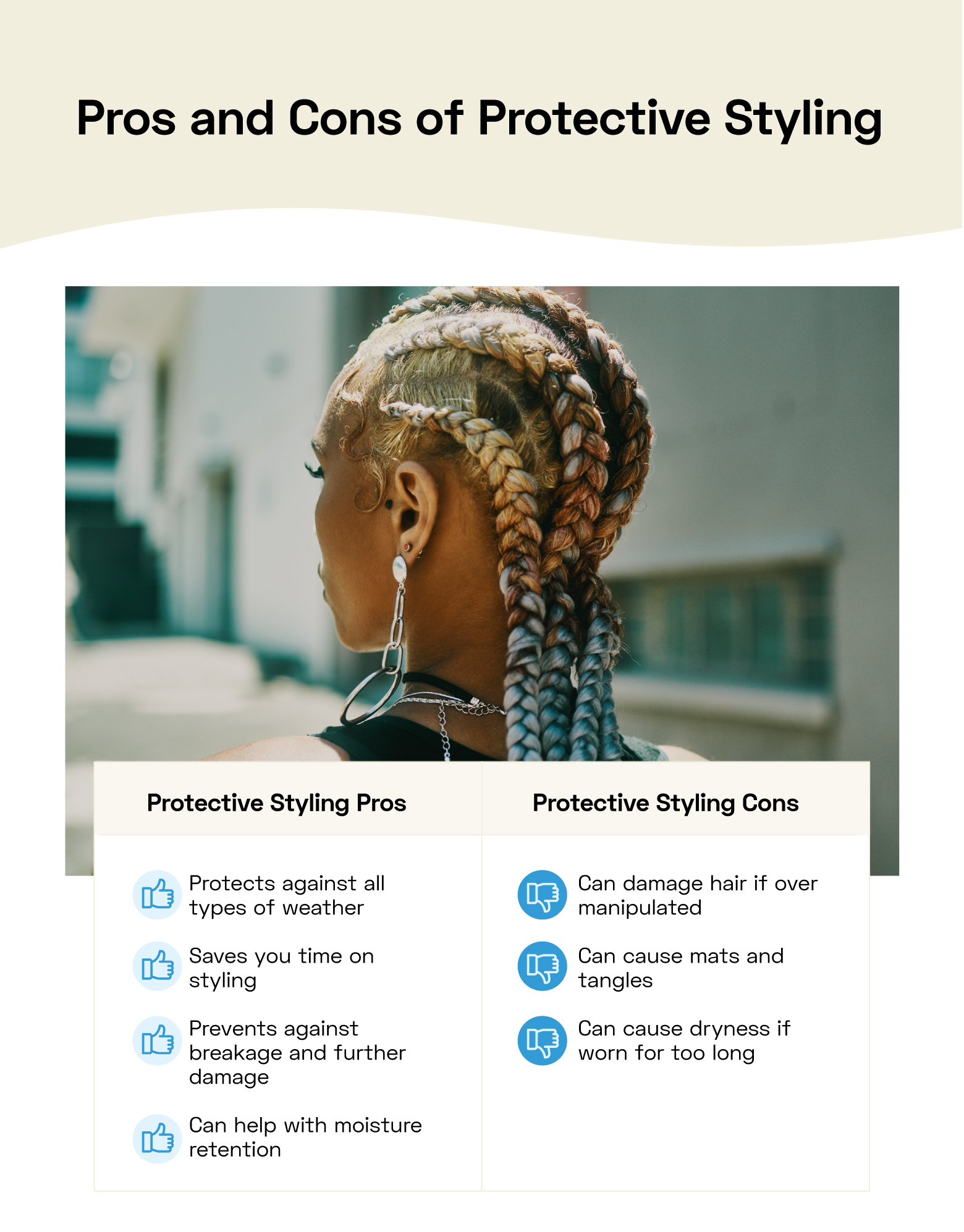
Pros:
- Protects against all types of weather: Your hair is way less likely to frizz up from humidity or dry out from extreme temperatures if you’re wearing a protective style.
- Saves you time on styling: Since most can be worn safely for up to eight weeks, your hair is set and ready to go every day.
- Prevents against breakage and further damage: Protective styles are made to protect your hair from breakage and damage or give your damaged hair some necessary recovery time.
- Can help with moisture retention: Keeping your hair in a protective style helps lock in moisture from your products, especially if you’re washing less.
Cons:
- Over manipulation can damage hair. Just like playing with your hair or overcombing, too much activity or rough styling can encourage breakage.
- Protective styling can cause mats and tangles. Some protective styles involve twists and braids, which, if done incorrectly, can tangle your strands.
- Wearing protective styles for too long can cause dryness. If you keep your hair in a protective style for longer than eight weeks, buildup from natural oils and product residue can start to dry your hair out.
Best Products for 4a Hair
Try using some of these products designed for 4a hair.
1. Sulfate-Free Shampoos and Clarifying Rinses
Sulfate-free shampoos and clarifying treatments both address the issues that dryness-prone hair can face. While sulfate-free shampoos cleanse without stripping, clarifying treatments — including shampoos and rinses — clear away the oily buildup from your natural oils and moisturizing products, so you can keep your hydration in check.
2. Deep Conditioning Masks, Butters, and Creams
Deep conditioning masks, hair butters, and creams help replace and lock in moisture while also making hair easier to detangle. The drier or more prone to tangling your curls are, the heavier the conditioning product you’ll need.
Some deep-conditioning products also include protein treatments. This combination not only moisturizes, but also helps strengthen delicate and damaged hair by penetrating the hair shaft, helping to reconnect protein chains inside each of your strands.
3. Hair Oils
Using hair oils between washes can help refresh your curls and increase moisture, softness, and shine. Heavier oils, like coconut and olive oil, are good for thick and high-density hair, while lighter-weight oils, like jojoba and castor oil, are best for finer strands.
4. Moisturizing Styling Products and Leave-In Conditioners
Styling products can help define your curls if you use ones that work with your natural hair texture and don’t leave a flaky residue.
Moisturizing mousses and creams do double-duty for your hair by moisturizing while styling. If there’s a hair product you love that dries you out, applying a leave-in conditioner before you use it can help protect against overdrying.
Do’s and Don’ts for 4a Hair
If you’re overwhelmed by hair care and need a place to start, follow these essential hair care tips for maintaining healthy, beautiful 4a hair.
Do: Protect Your Hair at Night
Protecting your curls at night helps reduce the breakage and damage that can happen when you toss and turn. You can use a protective style like a bun or wrap your hair in a silk bonnet, cap, or scarf. Swapping out your pillowcases for silk ones can help by reducing friction, but covering your hair with a bonnet or cap is the best way to protect your locks.
Do: Try the LOC Method for Wash-and-Go Styles
The LOC method is a proven hydration technique for kinky hair. It involves layering moisturizers, by applying:
- Liquid to hydrate hair
- Oil to lock in moisture
- Cream to prevent moisture loss
While the types and amounts of products you can use depend on your personal hair needs, this method can help you make sure your hair stays fully hydrated. It works well with wash-and-go or wet set styles, helping your hair set as it dries.
Don’t: Touch Your Hair Constantly
Though your hands and fingers can sometimes be great styling tools, you can touch your curly hair too much. Playing with your delicate curls can cause issues like breakage and frizz and can ruin your curl definition.
Don’t: Be Too Rough When Brushing and Detangling
Because it’s so prone to breakage, brushing and detangling your 4a hair has to be done with care. Detangling hair while it’s wet, conditioned, and segmented into sections helps you work through knots and tangles more gently.
Conclusion
If you’re struggling to maintain your 4a hair, these hair care tips can help. Updating your hair care routine with more of what your hair really needs will get you healthy, hydrated, shiny curls in no time!
If you want more personal advice or are looking to change up your style, StyleSeat has you covered. Use our search tool to find and book a stylist near you.
